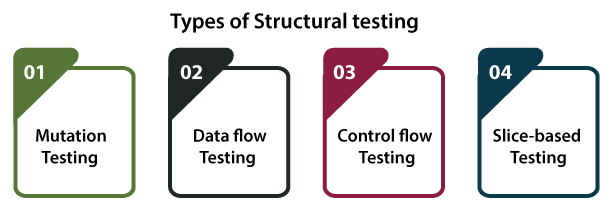In this section, we are going to understand structural testing, which is a significant part of Software testing.
And we also learn about its needs, types of structural testing, tools compatible for Structural testing, advantage, and disadvantage.
Introduction of Structural Testing
Another type of software testing technique is Structural testing, which is used to test the internal design of the software or structure of the coding for the particular software.
In this testing, the development team members are included in the testing team to execute the software's internal design. The working of structural testing is opposite to Behavioral testing.
In other words, we can say that structural testing tests the different features of an application based on its types.
Structural testing is also known as white-box testing, glass box testing, and clear-box testing. Developers mostly implement it to identify the issue and fix them quickly.
The structural testing process requires an in-depth knowledge of the programming language and is opposite to Functional Testing.
The knowledge of the code's internal executions and how the software is implemented is a necessity for the test engineer to implement the structural testing.
Throughout the structural testing, the test engineer intends on how the software performs, and it can be used at all levels of testing.
For example, the coverage of menu options or significant business transactions could be the system's structural element or acceptance testing.
Types of Structural Testing
Structural testing is divided into four different categories, which are as follows:
- Mutation testing
- Data flow testing
- Control flow testing
- Slice-based testing

Mutation testing
- It is used to check the quality of the test case that should fail the mutant code.
- Mutation testing involves the development of new tests to be implemented on the software for its testing process.
- When we identify various errors, it implies that either the program is correct or the test case is inefficient in locating the fault.
- In the mutation testing, the developers make small modifications to the previously accessible software tests and generate a mutant of the old software test.
- It used to cause an error in the program, which implies that the mutation testing is performed to evaluate the test case's productivity.
Refers to the below link for detailed information about the Mutation testing: https://www.javatpoint.com/mutation-testing
Data flow testing
- It is a group of testing approaches used to observe the control flow of programs to discover the sequence of variables as per the series of events.
- It implements a control flow graph and analysis the points where the codes can change the data.
- If we execute the data flow testing technique, the information is kept safe and unchanged during the code's implementation.
Refers to the below link for the detailed information related to the data flow testing: https://www.javatpoint.com/data-flow-testing-in-white-box-testing
Control flow testing
- The control flow testing is the basic model of Structural testing.
- It is to check the implementation order of commands or statements of the code over a control structure.
- In the control flow testing, a specific part of an extensive program is selected by the test engineer to set the testing path.
- Generally, the control flow testing technique is used in unit testing.
- In this testing, the entire test is based on how the control is executed during the code.
- The complete information of all the software's features and logic is necessary to execute the control flow testing.
For detailed information about the Control flow testing is, refer to the below link: https://www.javatpoint.com/control-flow-testing-in-white-box-testing
Slice-based testing
- It was initially created and established to keep the software.
- The basic idea is to sort the complete code into small chunks and then evaluate each portion carefully.
- The slice-based testing is very beneficial for the maintenance of the software along with fixing the application too.
Note: The developers can use these four types of structural testing as per their requirements.
Structural Testing Tools
Like other testing has their tools, structural testing also contains some open-source and commercial tools that have their functionality.
Some of the most commonly used tools for structural testing are as follows:
- Cucumber
- JBehave
- Cfix
- JUnit
Let understand them one by one in details:
Cucumber

It is a widely used tool for behavior-driven Development as it delivers an easily understandable testing script for system acceptance and automation testing.
It is a software tool used by the test engineer to develop test cases for the testing of the software's behavior.
For more information about the cucumber tool, we can refer to the following link: https://www.javatpoint.com/cucumber-testing-introduction
JBehave
It is a framework for BDD (Behaviour-Driven Development). The BDD is a development of TDD (test-driven Development) and acceptance-test-driven design. It is planned to create these practices more accessible and spontaneous to beginners and professionals alike.

Features of JBehave
Some of the commonly used features of JBehave are as follows:
- It is purely executing in Java programming language, which plays well with Java-based enterprises.
- In this, we can write the user stories in JBehave syntax/ Gherkin syntax.
- The user stories can be implemented as JUnit
- It provides the Annotation-based configuration and steps class specifications.
- It allows stories to be executed through Ant task.
Cfix
Another structural testing tool is Cfix, an XUnit testing framework supported by the C/C++ programming language.
In this tool, the unit tests are compiled and linked into a DLL. It has been designed to work well in combination with Windows Debuggers such as Visual Studio and WinDBG.
Characteristic of Cfix
Following are the commonly used features of Cfix:
- It supports development of both user and kernel mode unit tests.
- The failing test case can be highly customized in case of implementation.
JUnit

JUnit is one of the essential tools of structural testing. It is an open-source unit testing framework, which was written in Java language.
It will help us to enhance the developer's efficiency, which provides the consistency of the development code and reduces the time of the debugging.
For more details about the JUnit, refers to the below link: https://www.javatpoint.com/junit-tutorial
Advantages and Disadvantages of Structural Testing
Below are the benefits and drawback of structural testing:
Advantages of Structural Testing
The benefits of Structural testing are as follows:
- Structural testing does not require a lot of manual work as it is an automated process.
- Structural testing is not a time-consuming process.
- All the early defects can easily be identified
- It removes the dead code (extra code) or statements easily.
- It provides easy coding and implementation.
- It delivers detailed testing of the software.
Disadvantages of Structural Testing
The drawback of the structural testing are as follows:
- To perform structural testing, in-depth knowledge of programming languages is required.
- Even though structural testing is automatic, it might turn out very difficult because it involves training in the tool used for testing.
- It is expensive in respect of money because sometimes resources are necessary to efficiently perform structural testing.
- There is also a small chance that some commands, statements or branches could be missed unintentionally.
Overview
In this tutorial, we have understood structural testing, the type of structural testing, advantages and disadvantages.
After learning all the specific topics, we can easily conclude that Structural testing, which is also called White-box testing, glass box testing, and clear box testing is used to verify the structure of code.
And apart from that, we can say that while executing the different types of software testing, there is no guarantee of 100% efficiency of the product. Therefore, it is always helpful if we associate different categories of testing and methods.
The various structural testing types, which we have looked at, such as data flow testing, mutation testing, slice-based testing, and control flow testing, could be copied back to errors such as:
- Mutation testing (using the wrong operator).
- Data flow testing (referencing a variable before using it).
In case someone is looking to use the structural testing methods, they need to consider both the benefits and drawbacks of the structural testing.
Furthermore, they need to take care of the fact that structural testing is implemented successfully.



0 Comments